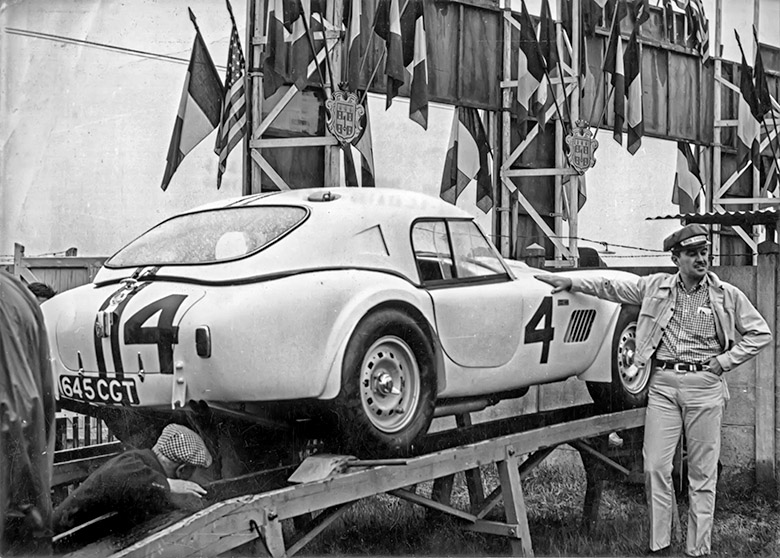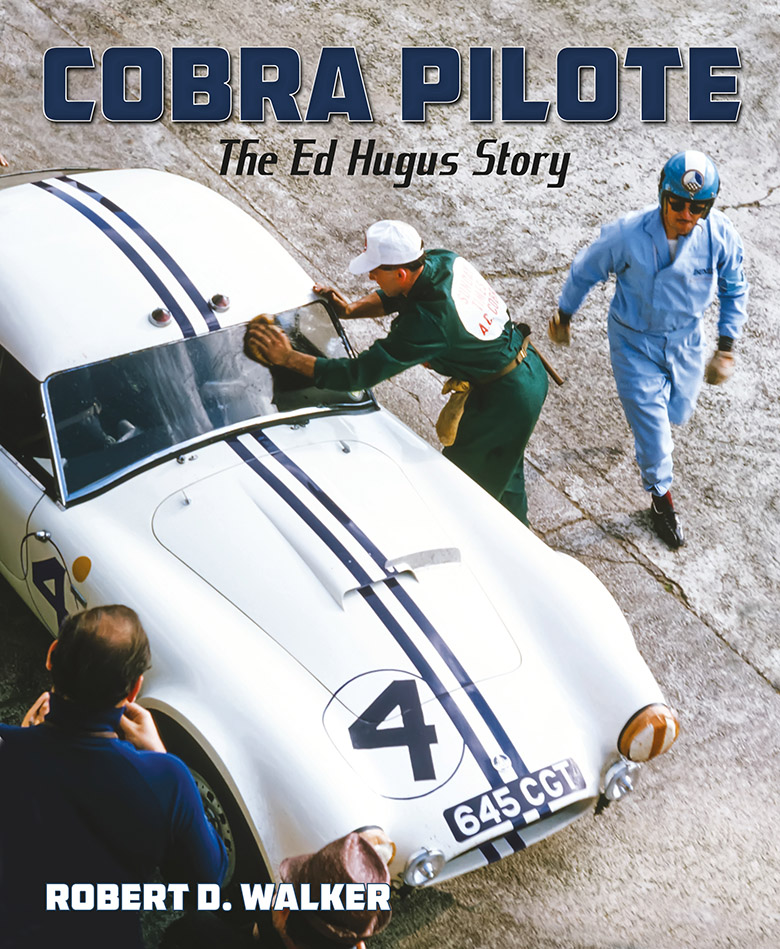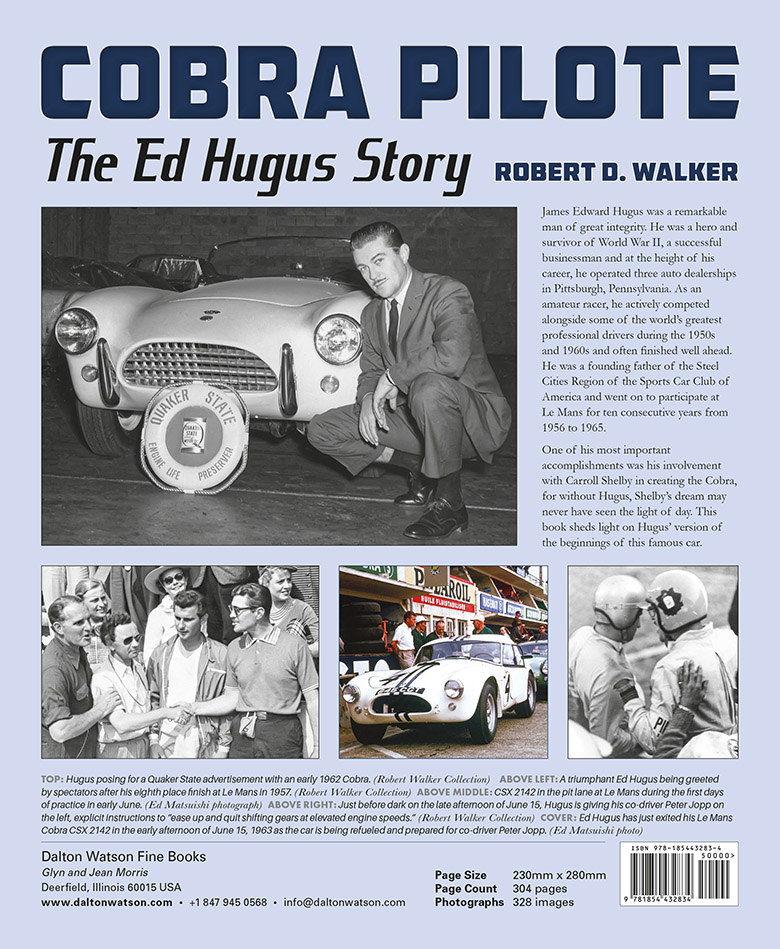
Ed Hugus poses with one of his early production Cobras. He was to install the Ford V8s and finish off the first few Cobra 260s for Shelby. Author Robert Walker tells the story in Cobra Pilote, The Ed Hugus Story.
Cobra Pilote: the Ed Hugus Story
By Robert D. Walker
Hard cover with dust jacket 280mm by 230mm
304 pages
328 black and white, and color photographs
12 MyRewards points with purchase
ISBN 978-1-85443-283-4
US $89 plu shipping
Daltonw Watson, 2017 1-847-945-0569
Order Here
Review by Pete Vack
All photos from the book
Ed Hugus drove Alfas, Porsches, BMWs, Lotus, Ferraris and Coopers over his 15-year career as a race car driver. He also drove a Cobra at Le Mans in 1963, where it retired.
So one might wonder why his biography is entitled Cobra Pilote; the Ed Hugus Story. Probably because the author, who once lived close to Hugus and became a close confidant, is enamored with Cobras, and no doubt wanted make sure Ed gets the credit for being the first one to install a V8 into a production Cobra. In fact as Robert D. Walker tells us, Ed’s shop actually created about six or seven of the first Cobras, taking in the A.C. bodies from the UK and installing the Ford 260. Walker, for good reasons, wanted to set the record straight. It’s an interesting story, and never before told in such detail.
And detail it has. Cobra detail that is. Roughly one-third of the book is devoted to Ed’s role in the construction of those first production Cobras, the problems that forced Hugus to break off relations with Shelby and cease construction, the development of the Cobra Hugus set up to drive at Le Mans in 1963, and the race itself.
All good stuff. And rightly in one book, for there is not enough material to justify a book on the Hugus Cobras alone, nor enough material about Ed’s racing career to warrant a separate book. But put the two together, and Walker comes up with a 300-page book which centers on the activities of the likable, handsome Pennsylvania foreign car dealer and race car driver. It is packed with photos from the Hugus collection and full of recollections obtained on tape from Ed before he passed away in 2006, this will be the definitive book on the career of Ed Hugus, yet be of interest to Porsche, Alfa, and Ferrari enthusiasts as well as Cobra aficionados.

Hugus had a great sense of humor, and often wore his “Bus Driver Cap” while at Le Mans. Here he poses with the Cobra he set up to race at Le Mans in 1963.
It is a wonderful, fresh story but badly in need of some logical structure. Chapter One Driven to Success begins nicely with the early years of Ed’s dealership, but brings in many references to the Cobra venture which are then repeated in the following seven chapters, all of which are devoted to the Cobra in some fashion and in turn, contain repetition. The last chapter, Ed Hugus’ Racing History, finally covers Ed’s racing career year-by-year. A list of races entered would have been handy but results are buried in the text.

With the success of European Cars Inc. Hugus opened up International Motors and began to sell the Fiat line. He was not impressed.
Walker does a good job describing Hugus’ years as a foreign car dealer. With good looks, charm and a sincere interest in the new wave of foreign cars being imported from Europe and the UK, he found financing and backers to help him establish European Cars, Inc. and a bit later on, Continental Cars, which began to sell VWs. That was a very smart move financially and Ed was to be comfortable for the rest of his life. But he worked for every cent. Photos of the dealership remind us of what it was like in those days and how Volkswagen literally transformed the concept of a dealership. Hugus also carried Fiat for a while, and despaired over the premature rust and overall poor quality of the Italian cars. He dropped Fiat as soon as possible.

When service became overcrowded, Porsches from his Continental Cars would share bays with International Automobiles.
The author also explains the mystery of naming race cars Lucybelle, though not in clear terms. Lucybelle was Lucille Davis, who was the wife of the wealthy Parker Davis. The couple financed Hugus’ dealerships and Lucille helped manage the dealerships, though Ed had overall control. A Porsche entered at Le Mans in 1957 was the first named Lucybelle and the second was the Ferrari 250TR entered in the 1958 event. There was apparently more to that however, as when Parker Davis died, Lucy continued to back the dealerships. In 1968 they sold the Pittsburgh dealership and planned to retire, moving to Florida. Later, Hugus and Lucy bought homes together in Costa Rica and Atlanta. Hugus did not marry his wife Barbara until 1992.

Hugues at the wheel of the 1100cc Cooper Climax at Le Man, 1956s. He and John Bentley finished an amazing 8th overall and won entries into the next year’s event. Hugus would drive at Le Mans for ten years.
After establishing the successful dealerships in Pittsburgh, Hugus began racing in a variety of SCCA events and with the help of Leech Cracraft, obtained one of the early Cooper Climax sports racers. He found a willing co-driver in John Bentley and entered Sebring in 1956 but didn’t finish. But they had a spot at Le Mans and the pair finished eighth overall and second in the 1100cc class in the French classic. This earned Hugus the right to enter another Le Mans, which he did, and for ten years Ed would participate in the 24-hour race. This stroke of luck and skill was to shape Ed’s racing life for the next decade.
Hugus drove a number of Ferraris, and all have been chronicled elsewhere and Walker does not write a lot on the Ferrari years, but provides serial numbers and results, But Walker does includes the hybrid Lotus/Dino Ferrari that was put together by Hugus’ mechanic in the late 1960s. Throughout the book, Walker includes great photos of Ed’s years in competition with 328 excellent color and black and white images from the Hugus collection and other photographers as well. Many have never been published before and make the book well worthwhile.

The Rindt/Gregory 250LM SN#5893 at Le Mans in 1965. Did he or didn’t he take the wheel as a back up driver?
So what happened at Le Mans, 1965 where Hugus claims to have taken a turn driving the winning Ferrari? We thought you’d never ask. Walker comes up with some new data that sheds light on that foggy morning in France, and he does his best to settle the issue once and for all.
But we aren’t going to be a spoiler here. Walker has done a fine job and a lot of homework, and his book deserves a good read.


A great review of a great guy, Pete. I knew Hugus as well. He was full of stories. When I got in a jam writing an article, he would always bail me out with a few interesting bits for the readers. It’s too bad such people can’t live forever. I have my copy of the book unopened in a package from Dalton Watson. I’ll get into it as soon as I can finish off a bunch of projects. Work comes first.
Good shot of the #21 Ferrari 275LM during scrutineering at Le Mans. On the left is Masten Gregory second wife with what looks like a huge handbag. Or was it a tool box?